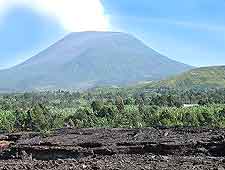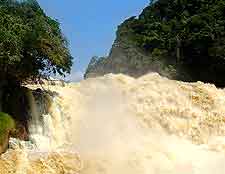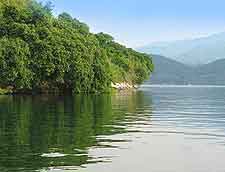Democratic Republic of the Congo History Facts and Timeline
(Democratic Republic of the Congo - DRC, CD, Central Africa)

It is difficult to say with any confidence that the Democratic Republic of the Congo will be a leading tourist destination any time soon, but it is slowly emerging from decades of war and bloodshed.
Many parts of the country are still off limits to most travellers and the capital, Kinshasa, has a high crime rate. However, more adventurous tourists might find one or two sights relating to the DR Congo's history.
Early Cultures
The oldest cultures to inhabit the country date back as far as the second millennium BC, although the region really began to take shape during the time of the Bantu Migrations. The Bantu displaced many of the indigenous pygmies, yet some still remain. Travellers staying in Goma, the most touristic city in the Democratic Republic of the Congo, can visit pygmy tribes in Minova.
The early Bantu-speaking civilisations slowly transformed the territory into the Kingdom of Luba, dependent on its rich supply of mineral ores, being home to a wealthy government by the 16th century.
Colonisation of the Country
European interest in the Congo began in the 1870s, with Belgian-sponsored visits led by explorer, Sir Henry Morton Stanley. By 1885, Leopold II, King of Belgium, had secured territorial rights and named it the Congo Free State. Leopold's exploitation of the native Congolese was at times brutal.
In the years leading up to 1908, millions of Congolese are believed to have died while producing rubber for the Belgians, and horrific amputations were also commonplace as punishments. This shameful period of African history was effectively told in Joseph Conrad's acclaimed work of fiction in 1899, entitled 'Heart of Darkness'.
Things only got better for the Congolese in 1908, when the Belgian parliament took control of the Congo Free State and renamed the territory the 'Belgian Congo'. Although conditions began to improve, there was still strong Congolese resentment towards their colonial masters.

Political Crisis
In May 1960, the political party named the Congolese National Movement, led by Patrice Emery Lumumba, won the national elections. Meanwhile, Joseph Kasavubu of the ABAKO party was elected as president. This led to the formation of the independent 'Republic of the Congo' in June 1960 and the beginning of rebellion in areas choosing to oppose the new regime.
The relationship between Lumumba and Kasavubu was strained from the very beginning and Lumumba was unsurprisingly ousted in September 1960. His execution took place in 1961 and the subsequent period leading up to 1965 was marked by a number of temporary administrations.
Army rebels led by Mobutu Sese Seko, which were mainly funded by the USA, eventually gained power by a coup d'état in 1965. The West had overcome the resident communist threat by managing this coup from a safe distance.
Zaire
With the backing of the USA, Mobutu became leader of the renamed territory, Zaire. Although this was a stable period in the history of the Democratic Republic of the Congo, corruption was rampant, standards of living deteriorated and human rights infringements were commonplace.
US support of the Mobutu regime lasted until the end of the Cold War, when Zaire was no longer needed in the fight against communism. Mobutu declared a new constitution in 1990, but his time was coming to an end. He eventually fled the country during the First Congo War in 1997, a revolution in which he was replaced by powerful rebel leader, Laurent Désiré Kabila.

The Second Congo War
At the end of the First Congo War, Zaire was renamed the Democratic Republic of the Congo. However, history shows that this meant little in reality and the country's deep-rooted problems remained, namely the ethnic conflict which had spilled into the east of the country from Rwanda.
Kabila's leadership was weak at best - his army was essentially run by the Rwandans and the Ugandans. It wasn't until after his assassination in 2001 that an uneasy peace broke out, with a deal brokered between the invading Rwandans, the Ugandans and his son, Joseph Kabila. UN peacekeepers soon arrived, but the fighting continued to ebb and flow over the next two years, as other African strongmen like Zimbabwe's Robert Mugabe, sent in troops to shore up a government that had sold off lucrative mineral rights to create allies.
Things came to a head after the disputed results of a 2006 election led to bloodshed on the streets of Kinshasa. United Nations peacekeepers took control of the city's streets, before a second election in 2011 saw Joseph Kabila unanimously emerge as winner and president of the DR Congo.
 It is difficult to say with any confidence that the Democratic Republic of the Congo will be a leading tourist destination any time soon, but it is slowly emerging from decades of war and bloodshed.
It is difficult to say with any confidence that the Democratic Republic of the Congo will be a leading tourist destination any time soon, but it is slowly emerging from decades of war and bloodshed.
